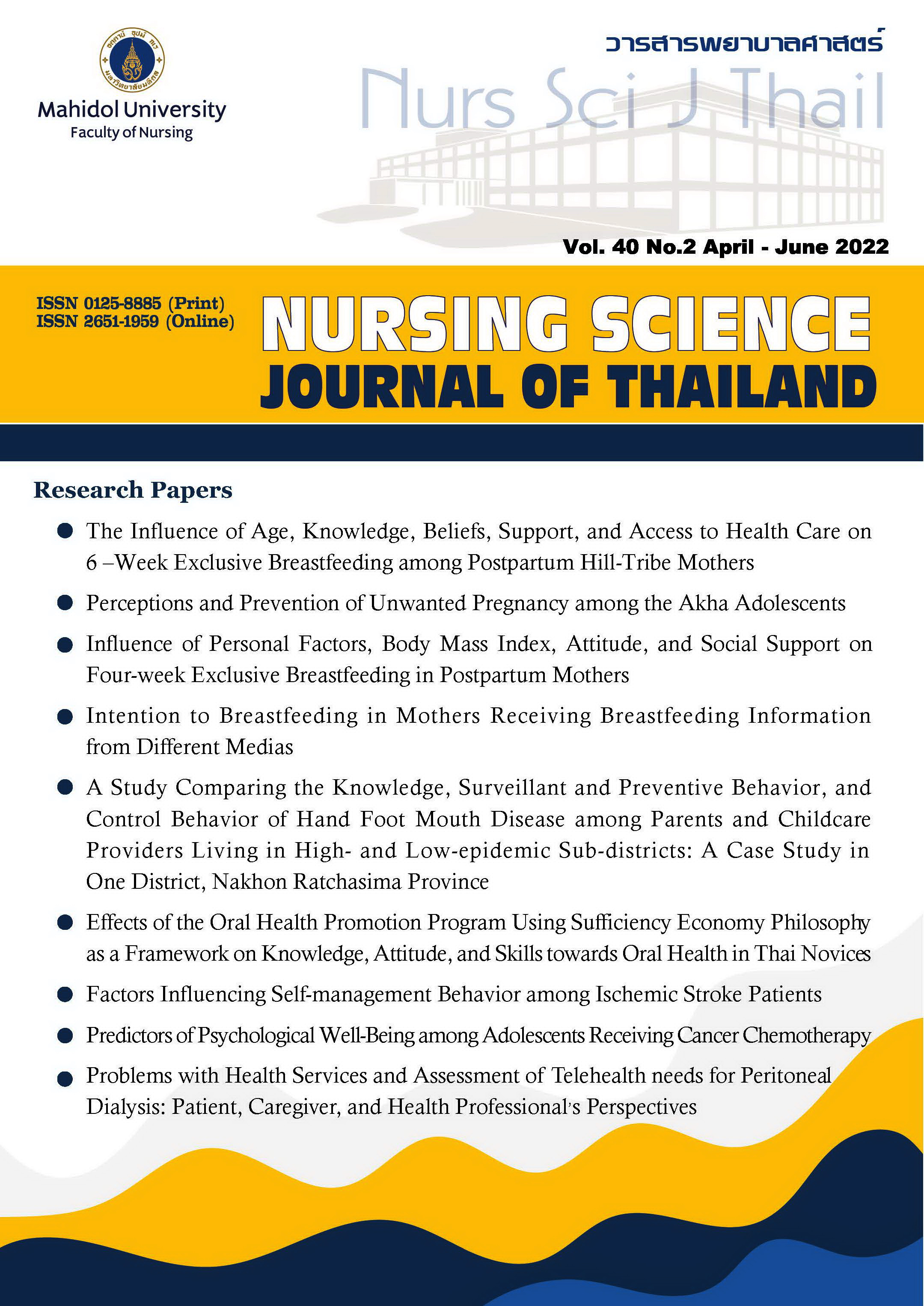การรับรู้และการป้องกันการตั้งครรภ์ไม่พร้อมในวัยรุ่นกลุ่มชาติพันธุ์อาข่า
Main Article Content
บทคัดย่อ
วัตถุประสงค์: เพื่อศึกษาการรับรู้เกี่ยวกับการตั้งครรภ์ไม่พร้อมและการป้องกันการตั้งครรภ์ไม่พร้อมในวัยรุ่นกลุ่มชาติพันธุ์อาข่า จังหวัดเชียงราย
รูปแบบการวิจัย: การวิจัยเชิงคุณภาพ
วิธีดำเนินการวิจัย: ศึกษาในวัยรุ่นกลุ่มชาติพันธุ์อาข่า จำนวน 42 คน ในจังหวัดเชียงราย รวบรวมข้อมูลด้วยการสัมภาษณ์แบบเจาะลึกรายบุคคลโดยใช้แบบสัมภาษณ์กึ่งโครงสร้าง วิเคราะห์ข้อมูลโดยสถิติเชิงพรรณา และวิเคราะห์เนื้อหา
ผลการวิจัย: 5 ประเด็นหลัก ได้แก่ 1) การตั้งครรภ์ไม่พร้อมเป็นปัญหาต่อตนเอง ครอบครัว และสังคม เป็นเหตุการณ์ที่ไม่ควรเกิดขึ้น 2) ความรู้เกี่ยวกับการตั้งครรภ์ไม่พร้อมและการป้องกันการตั้งครรภ์ไม่พร้อมที่ได้รับจากโรงเรียน ครอบครัว ชุมชน และบุคลากรทางสุขภาพ 3) การป้องกันการตั้งครรภ์ไม่พร้อมเป็นความท้าทาย 4) ปัจจัยที่มีผลต่อการตั้งครรภ์ไม่พร้อม 5) ความต้องการเสริมสร้างความรู้และบริการสุขภาพเพื่อป้องกันการตั้งครรภ์ไม่พร้อม ซึ่งการรับรู้ทั้งหมดนี้มีผลต่อพฤติกรรมการป้องกันการตั้งครรภ์ไม่พร้อมในวัยรุ่นกลุ่มชาติพันธุ์อาข่า
สรุปและข้อเสนอแนะ: วัยรุ่นกลุ่มชาติพันธุ์อาข่ามีมุมมองต่อการตั้งครรภ์ไม่พร้อมเป็นไปเชิงลบ การป้องกันการตั้งครรภ์ไม่พร้อมเป็นสิ่งที่ท้าท้าย เนื่องจากมีหลายปัจจัยที่ส่งเสริมให้มีเพศสัมพันธ์ที่ไม่ปลอดภัย ส่วนใหญ่ผู้ให้ข้อมูลได้เรียนรู้การตั้งครรภ์ไม่พร้อมและวิธีป้องกันจากโรงเรียน แต่จากชุมชนและบุคลากรทางด้านสุขภาพยังค่อนข้างน้อย การศึกษานี้มีข้อแนะนำว่าบุคลากรทางด้านสุขภาพควรเข้าไปให้ความรู้ในเรื่องวิธีป้องกันการตั้งครรภ์ไม่พร้อมในโรงเรียนและชุมชน และพัฒนาแอปพลิเคชันการเรียนรู้แบบออนไลน์ที่สอดคล้องกับบริบทและวัฒนธรรมของวัยรุ่นกลุ่มชาติพันธุ์อาข่า
Article Details

อนุญาตภายใต้เงื่อนไข Creative Commons Attribution-NonCommercial-NoDerivatives 4.0 International License.
ลิขสิทธิ์: วารสารพยาบาลศาสตร์เป็นเจ้าของลิขสิทธิ์ในการเผยแพร่ผลงานที่ตีพิมพ์ ห้ามผู้ใดนำบทความที่ได้รับการตีพิมพ์ในวารสารพยาบาลศาสตร์ไปเผยแพร่ในลักษณะต่างๆ ดังต่อไปนี้ การส่งบทความไปตีพิมพ์เผยแพร่ที่อื่น การนำบทความเผยแพร่ออนไลน์ การถ่ายเอกสารบทความเพื่อกิจกรรมที่ไม่ใช่การเรียนการสอน ยกเว้นเสียแต่ได้รับอนุญาตจากวารสารพยาบาลศาสตร์

Disclaimer: เนื้อหาบทความหรือข้อคิดเห็นใดๆ ในวารสารพยาบาลศาสตร์ ถือเป็นความรับผิดชอบของผู้เขียน กองบรรณาธิการไม่จำเป็นต้องเห็นด้วยและไม่มีส่วนรับผิดชอบแต่อย่างใด
เอกสารอ้างอิง
United Nations Population Fund. Girlhood, not motherhood: preventing adolescent pregnancy. New York: UNFPA; 2015. 58 p.
Sukrat B, Okascharoen C, Rattanasiri S, Aekplakorn W, Arunakul J, Saejeng K, et al. Estimation of the adolescent pregnancy rate in Thailand 2008–2013: an application of capture-recapture method. BMC Pregnancy Childbirth. 2020;20(1):120. doi: 10.1186/s12884-020-2808-3.
Unite for Children. Situation analysis of adolescent pregnancy in Thailand: synthesis report 2015. Bangkok: UNICEF; 2015. 42 p.
Aziato L, Hindin MJ, Maya ET, Manu A, Amuasi SA, Lawerh RM, et al. Adolescents' responses to an unintended pregnancy in Ghana: a qualitative study. J Pediatr Adolesc Gynecol. 2016;29(6):653-8. doi: 10.1016/j.jpag.2016.06.005.
Ganchimeg T, Ota E, Morisaki N, Laopaiboon M, Lumbiganon P, Zhang J, et al. Pregnancy and childbirth outcomes among adolescent mothers: a World Health Organization multicountry study. BJOG. 2014;121 Suppl 1:40-8. doi: 10.1111/1471-0528.12630.
Colquitt CW, Martin TS. Contraceptive methods: a review of nonbarrier and barrier products. J Pharm Pract. 2017;30(1):130-5. doi: 10.1177/0897190015585751.
Aliyu B, Onwuchekwa C. Birth control: contraceptive drugs/pills and methods in the last decades. Trop J Obstet Gynaecol. 2018;35(3):233-40. doi: 10.4103/TJOG.TJOG_11_18.
Abiodun OM, Balogun OR. Sexual activity and contraceptive use among young female students of tertiary educational institutions in Ilorin, Nigeria. Contraception. 2009;79(2):146-9. doi: 10.1016/j.contraception.2008.08.002.
Asnong C, Fellmeth G, Plugge E, San Wai N, Pimanpanarak M, Paw MK, et al. Adolescents’ perceptions and experiences of pregnancy in refugee and migrant communities on the Thailand-Myanmar border: a qualitative study. Reprod Health. 2018;15(1):83. doi: 10.1186/s12978-018-0522-7.
Bonkuea P. A study of unwanted teenage pregnancies in Pathiu District, Chumphon Province. Community Health Development Quarterly Khon Kaen University. 2017;5(2):195-216. (in Thai).
Udmuangpia T, Häggström-Nordin E, Worawong C, Tanglakmankhonge K, Bloom T. A qualitative study: perceptions regarding adolescent pregnancy among a group of Thai adolescents in Sweden. Pac Rim Int J Nurs Res Thail. 2017;21(1):75-87.
Jonas K, Crutzen R, van den Borne B, Sewpaul R, Reddy P. Teenage pregnancy rates and associations with other health risk behaviours: a three-wave cross-sectional study among South African school-going adolescents. Reprod Health. 2016;13(1):50. doi: 10.1186/s12978-016-0170-8.
Sychareun V, Faxelid E, Thomsen S, Somphet V, Popenoe R. Customary adolescent sexual practices among the Akha of northern Lao PDR: considerations for public health. Cult Health Sex. 2011;13 Suppl 2:249-62. doi: 10.1080/13691058.2011.634924.
Tawatchai A, Pilasinee W, Siriyaporn S, Thapakorn R. Health situation of Akha hill tribe in Chiang Rai Province, Thailand. J Public Hlth Dev. 2016;14(1):77-97.
Yimyam S, Narin R. Sexual risk behaviors and family violence among Akha women. Nursing Journal. 2014;42(4):146-55. (in Thai).
Lyttleton C, Sayanouso D. Cultural reproduction and “minority” sexuality: intimate changes among ethnic Akha in the upper Mekong. Asian Stud Rev. 2011;35(2):169-88. doi: 10.1080/10357823.2011.575205.
Moser A, Korstjens I. Series: Practical guidance to qualitative research. Part 3: Sampling, data collection and analysis. Eur J Gen Pract. 2018;24(1):9-18. doi: 10.1080/13814788.2017.1375091.
Crabtree BF, Miller WL. Doing qualitative research. London: SAGE; 1992. 50 p.
Leifer G. Introduction to maternity & pediatric nursing. 6th ed. St. Louis, MI: Elsevier; 2011. 841 p.
Onyeka IN, Miettola J, Ilika AL, Vaskilampi T. Unintended pregnancy and termination of studies among students in Anambra State, Nigeria: are secondary schools playing their part? Afr J Reprod Health. 2011;15(2):109-15.
Pillay N. Pathways to school completion for young mothers: are we winning the fight? SAJCH. 2018;12(2 Suppl 1):S15-8. doi: 10.7196/sajch.2018.v12i2.1530.
Ssewanyana D, Mwangala PN, Marsh V, Jao I, van Baar A, Newton CR, et al. Young people’s and stakeholders’ perspectives of adolescent sexual risk behavior in Kilifi County, Kenya: a qualitative study. J Health Psychol. 2018;23(2):188-205. doi: 10.1177/1359105317736783.
Mangkhang W, Kumsuk S. Family communication, attitude, and practice related to friendships among junior high school students in Nakhon Lampang Municipality. Journal of Boromarajonani College of Nursing, Bangkok. 2014;30(3):45-53. (in Thai).
Ministry of Education. Review of comprehensive sexual education in Thailand. Bangkok; 2016. 66 p. (in Thai).


